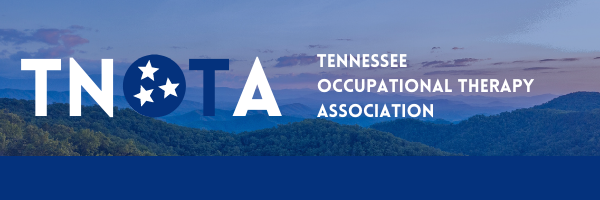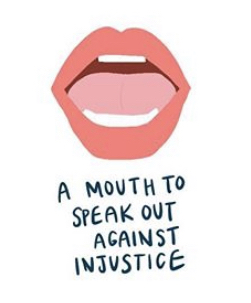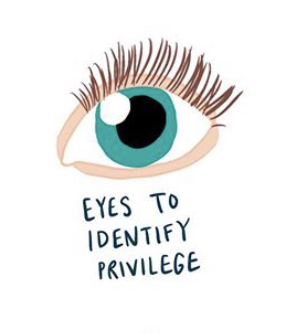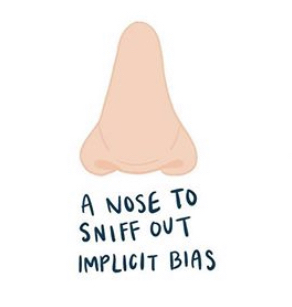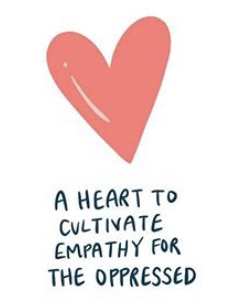|
Ever wonder how you can partner alongside marginalized groups to make change? What exactly does it mean to be an ally? Part 1. Introduction: "What is An Ally?" I’ll never forget the day that I stood over a cadaver for the first time. The smell of reeking formaldehyde still plagues my memory as I think about being tasked to identify every muscle, bone, and ligament in the human body. The brachial plexus still haunts me in the best way possible. As a new eager OT student, there was something about a lab coat and a summer dedicated to learning the human body that excited me. Human anatomy was the first class that I took as a graduate OT student; it was the foundation of my knowledge base as an occupational therapist. In that class I learned about all the body parts and how they functioned. I came to understand that our body parts allow us to engage with our environment and pursue occupations that give our life meaning. In addition to this, each our body parts have specific functions that allow us to connect with each other. Our mouth, nose, ears, eyes, and hands all play an integral role in how we connect with those around us. It is how we form bonds, relationships - it is how we ally together. What is an ally, exactly? An ally can be defined as a person that is associated with another or others for some common cause or purpose. We can also think of an ally as a partner, a teammate… your physical therapy partner co-treating on a complex case kind of thing. Allyship can look like Tennessee binding together for SuperBowl 1999 for the Tennessee Titans vs St. Louis Rams game (#TitanUp). But perhaps we can explore the word ‘ally’ as a verb: “to combine or unite a resource or commodity with another for mutual benefit”. Our world has shown us that injustice and the lack of allyship has been an unfortunate part of our human experience. You may wonder what the lack of allyship looks like in our daily lives? Well…
These are just a few of the many examples of marginalized communities and how they experience occupational injustice in many ways, every single day. By definition, we know that occupational injustice occurs when a person is denied, excluded from, or deprived of an opportunity to pursue meaningful occupations or when unchosen occupations are imposed upon them, thus limiting life satisfaction. With this series, we will explore how we can change these examples into opportunities to be OT practitioners who ally and serve as change agents committed to addressing these occupational injustices. The Tennessee Occupational Therapy Association (TNOTA) is committed to allyship through the promotion of diversity and inclusion within the OT profession. The new establishment of the Diversity and Inclusion committee is purposed with addressing areas of growth as it relates to diversity, equity, and inclusion for the OT profession in our state. The Diversity and Inclusion committee exists to amplify diversity in the field of occupational therapy, promote awareness about equality, and advocate for a more inclusive profession regarding scholarship and OT practice in the state of Tennessee. Our vision is a future in which Tennessee occupational therapy is more of an equitable, inclusive, and diverse representation of services for our community. So lets take a walk together- the next 6 months will explore how we as OT practitioners can partner together, as allies. If you are one who has not experienced these injustices personally, this series will explore how you can be an ally committed to making a change. It will explore how we can partner together with our mouths to speak out about injustice or how to use our noses to sniff out implicit bias. It will look at how we can use our eyes to identify privilege, and our ears to keenly listen to diverse experiences. It will address how our hearts can cultivate empathy for the oppressed. And most importantly - how we will join to together to use our hands to take actionable steps to make a change in the state of Tennessee. With allyship, we can be a community of practitioners who are better together - stronger together. Written by:
"It takes courage to speak up against complacency and injustice while others remain silent. But that's what leadership is." - Rosabeth Moss Kanter I remember throughout OT school our professors telling my cohort that ‘we are the future leaders of the profession’, which was quite intimidating. I didn’t feel qualified to be thrust into that role – I could barely perform a dependent transfer without being terrified of dropping the patient! But as I progressed through the program, to fieldwork, and now being a practicing therapist, I understand what they meant. Leadership is in the minutia, the little moments, the daily conversations. Effective leadership is a posture, not a title. The same applies to our role as allies. As allies with a passion for diversity, equity, and inclusion, we must recognize that we are also leaders. We have the unique opportunity to recognize injustices in the humdrum moments of work and practice and speak out against them. In every moment that we experience or recognize aggression, microaggression, bigotry, ignorance, and/or racism, we must use our mouths to speak. Creative Equity Toolkit has outlined two ways to approach and speak out: Calling Out & Calling In. Calling Out is appropriate when someone’s behavior is harmful, unacceptable, and must immediately be stopped to protect others. Example: You are an occupational therapist co-treating with a physical therapist who is a person of color. You both walk into the patient’s room and the patient immediately states, “I will work with you, but I won’t let them touch me.” When considering this approach, ask yourself these questions:
If you answered yes, consider these phrases to Call Out:
Calling In is appropriate when a discussion can be used to guide someone to deeper understanding, empathy, and change. Example: A coworker is reviewing a chart of a new patient who is a transgender male. The chart indicates that the patient uses he/him pronouns and uses the name Eric. The automated demographic information from the computer system reports “Smith, Emily. Female”. Your coworker uses she/her pronouns and the name Emily when referring to the patient.” When considering this approach, ask yourself these questions:
If you answered yes, consider these phrases to Call In:
The next time you encounter injustice as an occupational therapy practitioner, consider your role as a leader and ally. How can you use your knowledge of diversity, equity, and inclusion to Call Out or Call In to create effective change in every moment; the moments that harken a hard pause, and the mundane moments that occur in the natural current of the day-to-day. Let’s continue to ally (verb) by using our mouths to create safe spaces and effective change. Written by: Resources: Call out & call in racism. (n.d.). https://creativeequitytoolkit.org/topic/anti-racism/call-out-call-in-racism Interrupting Bias: Calling Out vs. Calling In. (2018, August 1). Retrieved from http://www.racialequityvtnea.org/wp-content/uploads/2018/09/Interrupting-Bias_-Calling-Out-vs.-Calling-In-REVISED-Aug-2018-1.pdf Rosabeth Moss Kanter Quote: "It takes courage to speak up against complacency and injustice while others remain silent. But that's what leadership is..." (n.d.). https://quotefancy.com/quote/1264872/Rosabeth-Moss-Kanter-It-takes-courage-to-speak-up-against-complacency-and-injustice-while
Part 3: Eyes to Identify Privilege Our eyes are small but mighty elements of our body that hold the capacity to conduct how we see the world. As occupational therapy practitioners, we are trained to know how the eye works - and to identify deficits that can impact our patient’s ability to engage with their environment. I’ll never forget a patient that I had while working in acute care. Mrs. Jones was a 89 year old friendly lady who held a petite frame, a smile almost wider than her face, and eyes that pleasantly greeted me as I entered her room. My occupational consult simply read, “right visual deficit, assess and treat”. After Mrs. Jones pleasantly obliged our session, I assisted her out of bed and initiated a visual training game while standing at the sink. The object of the game was to identify self-care items placed on her right side using the scanning strategies that we trained on before the start of the game. As we began the game, laughter emerged from the room as Mrs. Jones fought to win what became a friendly competition. “You’ve got to be joshing me!” she blurted, as she realized some items were harder to find than others (in the southern world, “joshing” colloquially means “you're kidding me!”). While playing this game, it became clear that I had the advantage. While Mrs. Jones struggled to identify what was on her right side, I was able to clearly see what was before her. I hadn’t earned that right to “see”, I just could. I was able to see what was out of her field of view. Luckily, through therapeutic intervention I was able to help her use strategies to improve her scanning skills by the end of the session that day. As I pondered on this experience, I realized that this is not untrue to form in many of our personal lives. Having advantages (whether knowingly or unknowingly) can impact who we are and how we are able to see the world. This is the sentiment that I consider when I think about privilege. By definition, privilege can be defined as “a special right, advantage, or immunity granted or available only to a particular person or group”. In a lot of cases, we are unable to “choose” what privileges we hold, yet we all have them. What we CAN choose, however, is how we allow our privileges to shape who we are, how we think, and thus how we act towards those who are underprivileged. What can privilege look like in our everyday lives? Privilege can look like assuming someone else had the same opportunities that you did to pursue a career in OT. Privilege can look like turning a blind eye to racial injustice, simply because it does not impact you. Privilege can look like lack of advocating for a complex patient need, because “it’ll be someone else’s problem”. Privilege is when you think something is not a problem because it is not a problem to you personally. So how can we identify our blind spots to make a change? Let’s take a look at how the parts of an eye can help us identify privilege:
I don’t know what your specific privileges may be, but I invite you to explore them. As an ally, you can use your keen sight and awareness to promote equity, justice, and inclusion for those who do not share those same privileges. Like Mrs. Jones, you may be blissfully unaware of things out of your view - yet this does not mean that accountability is out of reach. As occupational therapy practitioners, we inherently understand the value of assessment and identification of treating a problem. This is the first step in recognizing privilege - the audacity and courage to self assess and identify your own privilege. The next step is identifying ways to use your advantages to uplift those who are disadvantaged. That is what ally ship looks like - that is what this series is exploring. By self assessing and taking action, we can move forward as a community of allies who are equipped to better serve our patients, and better serve the world around us. Written by:
Part 4: A Nose to Sniff Out Implicit Bias Hopeless. That was the word that swarmed this mother’s mind, as she cradled her two shaking children on this frigid Tennessee night. An evening full of laughter and smores making earlier that evening now turned into an early morning wake up call to a screeching fire alarm. Although this mother had not seen the fire herself, she could smell the smoke from her 2nd floor bedroom as the dark grey hue slowly filled the room. In assessing a plan to escape, her mind drifted to her sleeping pets only a floor below her. They must be closer to the flame, she thought. As the minutes drifted by, she knew she had to come up with something to get her and her family out of harm’s way. In considering a fire, one may wonder: is it the flame or the inhalation smoke that the mother should worry about first? Regardless, the first thing that transpired was the mother’s detection of danger. Our noses serve as a powerful sense that can help us detect many things in our environment. Whether it is the fragrant smell of a rose garden or the pungent smell of a dumpster, we are typically able to identify things by simply smelling them. Similarly, as occupational therapy practitioners, we can use our noses to ‘sniff’ out implicit bias. What is implicit bias, exactly? According to the social identity theory, implicit bias is the “pre-reflective attribution of particular qualities by an individual to a member of some social out group”. In other words, it is when we have attitudes or stereotypes about certain groups of people without our conscious knowledge. Our thoughts and feelings are “implicit” if we are not aware of them to begin with, or are mistaken about their nature. We have a bias when, rather than being neutral, we have a preference for (or aversion to) a person or group of people. Here is the truth: We ALL have implicit bias. Whether they are known or unknown, we are all prone to having thoughts or attitudes towards people that may stem from our upbringing, experiences, or environment (as just a few examples). Bias itself may not be harmful in some cases, but it can become harmful when we are unaware of it and we act in way that may inadvertently harm someone else. So what can be done to mitigate implicit bias? We can choose to address our implicit bias by first identifying and acknowledging it. One practical way to do so is by self-reflection. Another way is to access resources that may help you identify your personal biases. One resource is Project Implicit, a non-profit organization through Harvard University that collaborates internationally with researchers to study and educate the public on implicit bias. If interested in identifying your implicit bias, check out https://implicit.harvard.edu/implicit/takeatest.html to take an Implicit Association Test (IAT). You may be wondering what happened to the mother, her children, and her pets that evening. Thankfully, local firefighters responded to the call and were able to rescue all parties from the burning house. Hypothetically, whether you identify with being harmed by the ‘flame’ of implicit bias, or you identify with the inadvertent yet dangerous nature of the inhalation smoke (acting on your biases), we are all at risk of damage here. For some, it requires a ‘firefighter’, or fellow ally to help facilitate awareness and change. Other times, we can address the fire ourselves by taking actionable steps towards justice. Either way, in choosing to identify and address personal bias, we are forging a pathway of equitable and inclusive spaces not only for our patients, but for ourselves. Occupational therapy practitioners can be on the front lines of transformative justice through allyship by sniffing out and detecting our implicit biases. In doing so, we can play a part in the big picture of a more diverse, equitable, and inclusion world. Written by: Resources: Implicit bias Explained. (2017, May 17). Retrieved January, 2021, from https://perception.org/research/implicit-bias/
Part 5: Ears to Listen to the POC Experience I was in the middle of my commute to work one day and noticed one of my favorite songs came up on my playlist. I was tired, not terribly excited about going into work, but I was energized to hear this song. All of the sudden, I realized the song was over. I hadn’t wiggled in my seat pretending to be a back-up dancer. I hadn’t hummed (sang off key - very loudly) to any of the lyrics. I heard the music, but I was too preoccupied with my thoughts to listen. When we commit to hearing as an ally, we commit to listening to someone else’s experience and knowledge. We commit to the idea that hearing is not a solo act; an ally cannot hear without another voice being present. We also cannot be passive receivers of sound without engagement, as I was in my car. Hearing as an ally is an active, communal experience that is better characterised as listening. Listening is not a passive state; listening is an action, a skill, and requires concerted effort. When listening to marginalized experiences, we may be confronted with stories or ideas that do not fit into our current paradigm. This friction can cause us to become defensive and stop listening. We may completely disregard the speaker, we may start preparing what we are going to say in response, or we may even become argumentative. In order to be a true ally, we must engage with listening to marginalized voices and allow their words to affect us, shape our understanding of the world and the efforts of our advocacy. When we do this, we become a stronger, wiser, and more empathetic ally community. “We think we listen, but very rarely do we listen with real understanding, true empathy, Yet listening, of this very special kind, is one of the most potent forces for change that I know.” - Carl Rogers Written by:
Part 6: A Heart to cultivate empathy for the oppressed Oppression does not deserve a place in this world and does not deserve a place in our hearts, but it still exists. Cruel. Unjust. Mistreatment. Unfair. Hurtful. Abuse. Unequal Power. There are so many different words that can be used when speaking about oppression. Oppression is something that has occurred historically in the world and is still very prevalent today in many different forms: privilege, racial oppression, class oppression, gender oppression, and sexual oppression are just a few examples. People that are oppressed are generally oppressed because of who they are or because of factors that are out of their control. Their skin may be darker than yours; they may not live within the same means as others, or maybe they identify differently than you. Oppression isn’t just individuals using insults, violence, racial slurs, or homophobic statements. It can go much deeper than that. Oppression can occur systemically in the form of policies, practices, and regulations that are deeply rooted and perpetuate the mistreatment of marginalized individuals. It’s a way for individuals to try and control other people by making them feel inferior or by creating more barriers and hurdles for them. Luckily, we have a heart. The heart is a pump. It takes in blood from veins that have depleted their oxygen and sends it to the lungs. Then the left side of the heart sends the new oxygen rich blood to the rest of your body. Essentially, the heart helps to keep you refreshed and healthy. This is essentially the way empathy works. We take in what we hear or learn from others and process it in way that helps us understand the feelings of others. As an African American, cisgender male, I can never truly understand the discrimination, stigma, and oppression that is experienced by a Caucasian, transgender person who may not be able to see his family due to being rejected for their sexual identity. In the same way, that individual may not be able to fully understand the experience and importance of finding an appropriate school district where their children will feel safe and welcome and not be picked on due to their skin color. Even though I may not fully understand their experiences and they may not understand mine, when empathizing with each other, we can listen and understand the feelings that are being experienced. Even though we all have walked different paths and have had different experiences, we need to be able to empathize with each other. When we do that, then we are better able to connect with people and come together to show love for one another. As mentioned above, we can take in and listen to the negative experiences of one another and use that to show the other person that we care, and we can create a safe environment for them to feel heard and understood. We can use our heart and empathy to show that they have an ally. As an occupational therapy practitioner, we need to be able to empathize with our clients. We will never be able to walk in our client’s shoes, and we will never fully understand what they are going through. But we can and must listen to them and their stories in order to cultivate a safe environment to harbor success and growth. We have to show them that we care, and that while we aren’t walking in their shoes, we are walking beside them on their way to success, whatever that may look like for them. “Empathy is a quality of character that can change the world” – Barack Obama Written by:
Part 7: Hands to Take Action And Make A Change “We know we cannot plant seeds with closed fists. To sow, we must open our hands.”- Adolfo Perez Esquivel Ahhh, the hand brings back sweet memories of studying long hours in anatomy during OT school. During school, we were randomly selected to complete a major assignment in anatomy. I was hoping that my group would receive any other part of the body to complete BUT the hand. I already knew that the hand was complex, intricate and very detailed. Well, you guessed it right! We were assigned to complete the hand. The anxiety rushed through my body as if it was a gust of wind entering from my head all the way to the tip of my toes. Needless to say, my group completed the assignment and passed (whew). The size of the hand is small compared to other body parts; however, the hands are capable of a wide variety of functions. The hands assist with manipulation, fine motor skills, dexterity, making a fist and so much more. The forearm is a separate body part but the muscles of the forearm run into the hand to assist with flexion and extension. The hand is so important that it needs support from the forearm to take action. Let’s look at how we can break down the H.A.N.D. to understand the importance. The letter “H” stands for healing, “A” is for accomplishments, “N” is for necessary and “D” is for determination. The H.A.N.D. allows the actions of healing through accomplishments that are necessary to make a change through determination. As occupational therapy practitioners, we need to continuously examine the type of seeds we allow our hands to plant. Do we plant good seeds when we see a colleague struggling because a patient prefers not to be treated by a minority? Do we plant good seeds during treatment by embracing those who are statistically likely to get caught in the school-to-prison pipeline? Do we remain silent and allow others to sow negative seeds when a patient’s disability rights are violated? As occupational therapy practitioners, we are advocates who are creative with our approaches. There are creative ways to address issues that patients and colleagues may experience. Previously, we noted the hand needing support from the forearm to take action. The forearm can be viewed as the ally of the hand which supports the actions that are needed to make changes. We can be that helping H.A.N.D. that will make changes through support by doing the following action steps:
As the series of Anatomy of An Alley is completed, let us remember to plant prosperous seeds with open hands allowing for change. I would like to leave you with one question: what type of seeds are you allowing your H.A.N.D.S. to plant? Written by: |
